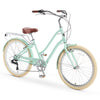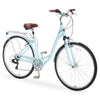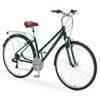Gears & Shifting 101: 3 Speed vs. 7 Speed Bikes
Copy Link
http://www.sixthreezero.com/blogs/bike-advice/gears-shifting-101-3-speed-vs-7-speed
New riders and cyclists who have been riding for a while often have questions regarding the different bike speeds. They’re looking for the perfect bicycle for their riding conditions and goals, and they realize that having the correct bike with the right amount of gears is essential.
So, let’s talk about gears and shifting, and in particular the main differences between a 3-speed and 7 speed bike. A discussion about 3-speed vs. 7 speed needs to include pros and cons for both bikes, which ultimately hold as much weight as the rider puts on them.
What is a 3-speed Bike?
Let’s begin with the pros of 3-speed bikes. These bicycles have all of the gears and shifting mechanisms tucked neatly away, giving the cycle a clean and minimalist look. They’re also easy to maintain, as dirt, road tar and other gunk doesn’t get into the gears and wear them down prematurely.
Many riders are surprised to know that 3-speed bikes don’t have a chain that moves and don’t require a derailleur, which means that you can mount a chain guard with full coverage to your bike, keeping your drive train sealed from any elements that would destroy it. Plus, without a drive train exposed, your legs and pants stay cleaner.
In general, an internal hub like the 3-speed bike leads to less money coming out of your pocket for repairs caused by poor road conditions. Your drive train lasts longer and your hub has a less likely chance of being bumped out of alignment should your bicycle tip over. A 3-speed bike is easy to use and reliable. It lets you shift from a complete stop and you don’t have to worry about sloppy adjustments from gear to gear.
The cons? Your initial purchase of a 3-speed bike may be more, just because internal gearing systems are more complicated and more expensive. These highly engineered designs come with many small parts, which means standard repairs may set you back more than you’d pay with a 7-speed bike. It takes more time and expertise to work on a 3-speed bike, so riders should plan for a bit longer servicing time on one of these models. Thankfully, though, 3-speed bikes don’t normally need many repairs.
When is a 3-Speed Right for You?
So, let’s get down to brass tacks. How do you know if a 3-speed is just your speed? Choosing a 3-speed bike is probably the right choice if:
- You’re using your bike on a hilly commute in the city. Taking your chariot to work in San Francisco every morning? This type of bike will handle great on the pavement.
- Low-maintenance is high on your priority list. Maybe you love the experience of riding but you’re not much of a gearhead. Does the thought of tinkering with your bike on the weekends sound like a drag? A 3-speed with an internal hub is a good option.
- You don’t consider yourself a pro. Because a 3-speed can shift even at a stop, and the shifting requires less cable pull, the cables will not only last longer but are less likely to give you trouble when shifting. For newbies just moving up from a 1-speed, the 3-speed is a good stepping stone.
What is a 7-speed Bike?
It’s probably obvious that the primary difference between 3 speed and 7 speed bikes is the number of gears. But, their designs are dissimilar as well. Our 7-speed bikes use what many riders would refer to as a standard gearing mechanism for a bike, which includes different-sized cogs placed externally and shifted by moving the chain via a derailleur.
A 7-speed bike is a great bike for a person who rides on tricky terrain. It’s main purpose is to let the bike adapt to rough conditions and accommodate inclines, bumps and other difficulties. On a 7-speed bike, the lower gears make it easier to pedal and the higher gears allow for better movement going downhill. Compared to a 3-speed bike, a 7-speed is preferable for a rider who travels on varying terrain.
Professional cyclists ride 7-speed bikes because they can adjust the cycle’s gears according to personal preference. A 7-speed bike takes a bit more effort to operate, but it’s pretty simple to get the hang of it when you know about, and embrace, the learning curve.
Like a 3-speed bike, a 7-speed comes with a few cons, which include a greater need for mechanical repairs if the bike is typically taken out on rough terrain. The structural complexity of these bikes mean that if one cog breaks, the entire bike would likely need to be brought in to get work done.
When is a 7-Speed Bike the Right Choice?
When you’re weighing a 3-speed vs. 7-speed bike, how do you know if you’re ready for more complex gear shifting? Here are some scenarios where a 7-speed could make sense:
-
You plan on doing a lot of mountain biking. Shifting while in motion on a downhill run keeps you safe and allows you to gain some steam. If you know you’re going beyond paved terrain, get more gears.
-
You’re very price conscious. 7-speed bikes are often a bit more affordable at the start, and repairs can cost less as well.
-
You like to be in control. 7-speed models give you more ways to adjust the gears while you’re riding. For quick transitions on any terrain, you may feel like you’re more in control on a 7-speed – even if you’re on the pavement in the city.
Differences Between Men’s and Women’s Road Bikes
On top of the structural differences between 3- and 7-speed bikes, road bikes have varying features based on whether they’re men’s or women’s bicycles. Bikes for men and women have several key design differences. These variations are meant to accommodate the typical height and body types of men and women, but of course, there are always exceptions.
For instance, tall women may find themselves more comfortable on a men’s model, and shorter men may want a bike labeled for women. In the end, it’s all about finding the road bike that is safest and most comfortable for you. With that in mind, here are some key differences:
Handlebars: The width of your handlebars may not seem like a major consideration, but it should be. The wider your shoulders, the wider your handlebars should be so you can steer comfortably. Ergonomic handlebars set you up for easier navigation.
As a general rule, the handlebars on men’s road bikes are wider than those on women’s bikes. Men’s handlebars are about 42-44 cm (or about 16.5-17 inches) wide. Women’s 3- and 7-speed road bikes have handlebars that measure about 38-40 cm (around 15-15.5 inches).
Frames: The frames on women’s road bikes are also different than men’s bikes. The most noticeable difference is that the top tube on women’s models is slanted downward to make mounting the bike easier for shorter riders.
On a men’s road bike, the top tube is parallel to the ground – in other words, straight across. The top tube is also longer on a men’s road bike, which makes the entire bike longer to accommodate longer legs. On a women’s road bike, the seat may be higher to adjust for shorter legs with a long torso.
Seats: Many bikes have unisex seats that comfortably fit any rider, or you can swap out your bike’s original seat for a unisex seat at any time. When it comes to the seat that comes with your road bike, however, you’ll notice distinct differences.
A women’s road bike tends to have a wider seat and a men’s bike will have a narrow, long seat. Both types of seats are available in a variety of fabrics and levels of cushioning for your comfort. In the end, the choice between 3-speed bikes and 7-speed bikes is one a rider needs to make based on personal preference and intended use for the bike. Whichever bike you end up purchasing, you’re bound to enjoy it, as riding is one of the best activities there is.
Choosing Between Gendered Road Bikes
Getting answers to questions like “how does a 3-speed bike work?” and “how does a 7-speed bike work?” is just the first step to choosing your road bike. With so few unisex bikes on the market, an education in men’s vs. women’s bikes is also necessary. If you’re overwhelmed, keep these rules of thumb in mind as you choose a 3- or 7-speed road bike:
- Taller riders tend to be more comfortable on men’s bikes, regardless of gender.
- All short riders may prefer a women’s road bike for easier mounting and a shorter frame.
- Your personal comfort is more important than the gender label on the bike, so buy what fits your body best!
Ready to get riding? Join our Journey Club to uncover new and exciting ride locations around the globe!

Take our Free Body Fit Questionnaire
Similar Articles
If you fall outside the average measurements of most folks, you know that sizing items are...
Getting started when biking uphill, it's going to be hard when you start off, especially if...
Now that spring is here, it's sunny, you definitely want to get that vitamin D and...















